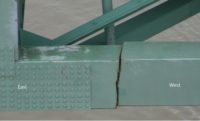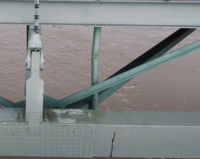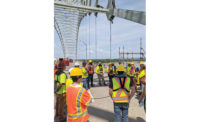Fractured Beam May Close Key Mississippi River Crossing for Months

A crack in one of two welded 24-in. x 32-in. continuous beams, each 900 ft in length, that form one of the bridge’s two tied-arch-truss navigation spans was discovered May 11 during a scheduled annual inspection.
Image courtesy of Arkansas Dept. of Transportation
Transportation officials in Arkansas and Tennessee say “a catastrophic event” was averted with the discovery of a fractured steel beam in the I-40 Mississippi River Bridge in Memphis. But it could be months before the busy mile-long crossing is fully repaired and reopened to traffic.
The crack in one of two welded 24 by 32 in., 900-ft-long continuous beams that form one of the bridge’s two tied-arch truss navigation spans was discovered May 11 during a scheduled annual inspection of the nearly 50-year-old crossing, also known as the Hernando De Soto Bridge. According to the Arkansas Dept. of Transportation, which shares the cost of operating the bridge with Tennessee’s DOT, the “fatigue-type fracture” likely resulted from decades of constant traffic movement, rather than a vessel impact or weather-related cause.
ARDOT officials say the crack did not appear during the bridge’s most recent inspection, which was completed last September. Upon discovery of the crack, the DOTs immediately closed the bridge to vehicles, while the U.S. Coast Guard temporarily halted barge traffic on the lower Mississippi River.
TDOT reported that three plates of the beam have separated by a fraction of an inch, while the fourth plate is cracked by more than 50%. Inspectors have so far found no evidence of any other structural issues. A comprehensive seismic retrofit, completed in 2011, focused mainly on bridge foundations and other elements. The beam where the crack occurred was not modified during that project, as it is not vulnerable to seismic event loading, ARDOT said.
As the agency responsible for the bridge’s routine and special inspections, ARDOT has retained forensic experts from HNTB to perform a complete diagnostic evaluation of the entire structure, which carries an average of 41,000 vehicles per day between the two states. While highway traffic between Arkansas and Tennessee has other options for crossing the Mississippi River, the closure is estimated to have idled more than 200 commercial vessels along the waterway.
“We’re hopeful short- and long-term solutions will be made available,” ARDOT Director Lorie Tudor said during a Wednesday press briefing. She added that Federal Highway Administration officials have assured her that federal funding will be available for the repairs, which TDOT will carry out.
According to TDOT Deputy Commissioner and Chief Engineer Paul Degges, repair plans will be developed under the agency’s on-call design contract with Michael Baker International, which conducted the structural inspection that identified the crack. TDOT will then procure a contractor using the states’ emergency contracting procedures.
“Since we do not have a design, we do not have the details for the contracting component as of yet,” Degges says, adding that the process could take several months to unfold.
ARDOT Assistant Chief Engineer of Operations Steve Frisbee said that while the simplest repair method would be to weld the fissure and add reinforcement plates, “this crack is pretty significant.” He added that the crack’s location approximately 110 ft above the river “makes it a challenge to repair.”





